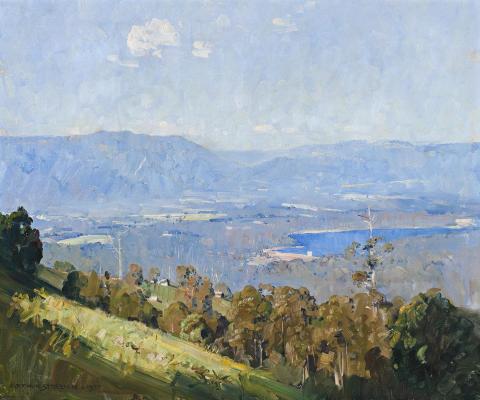OBSERVATORY ROAD, KALORAMA PARK, LOOKING TOWARDS SILVAN, 1937
ARTHUR STREETON
oil on canvas
62.5 x 75.5 cm
signed and dated lower left: ARTHUR STREETON . 1937.
Leonard Joel, Melbourne, 8 April 1987, lot 1296
Private collection, Melbourne
Thence by descent
Private collection, Melbourne
Great artists leave indelible impressions on the mind. Who can forget the surreal landscapes of Russell Drysdale or Fred Williams’ visions in minimalist shorthand, enriched with succulent colours and enticing textures? Arthur Streeton, like these and other greats, stamped his concept of the Australian landscape on the imagination of his and generations to come. His brilliant vision was so convincing that it became long accepted as the norm. Looking at his works today, one is captured equally by the lyrical paintings of his youth as by the grandeur of those of his maturity, of a sunbaked land girded in gold and blue. To this he added a feeling of light-filled atmosphere, so striking in Observatory Road, Kalorama Park, Looking Towards Silvan, 1937, that it is nigh tangible.
The year of our painting, 1937, was a triumphal one for Streeton, ushered in by his knighthood for services to art. This extended through successful solo exhibitions in Sydney and Melbourne, the Art Gallery of New South Wales purchasing from his Sydney show three works – Passing Showers, c.1937, Slopes of Olinda, 1936 and the still life, Melon. The art critic for the Sydney Morning Herald, when commenting on the ‘verve and brilliance’ of his paintings, wrote of the Slopes of Olinda, ‘every particle of the scene glows with light and animation. The treatment of trees in the foreground, painted in a beautifully free way, shows the master at the top of his form’.1 The Melbourne exhibition, which followed in September of 1937, was equally well received. While our painting has eluded identification as any work in either exhibition, Streeton did include several Olinda subjects which seem tantalisingly close.
During the twenties and thirties Streeton painted landscapes that became national icons. Foremost among these is The Land of the Golden Fleece, 1926. The three versions of this masterpiece are in the collections of the Australian Club, Sydney; the National Gallery of Australia, Canberra; and the National Gallery of Victoria, Melbourne. His Afternoon Light, Goulburn Valley, Victoria, c.1927 (also in the National Gallery of Australia) won the 1928 Wynne Prize. And Australian icons blend in Melba’s Country, 1936, Streeton’s special salute to his neighbour. 2 They were golden years in which he combined the untouched beauty of the Australian landscape with national sentiment and symbolically open skies, sunlight being a metaphor of freedom and opportunity. His panoramic harmonies of blue and gold also evoked associations of abundance as breathtaking as the scenes themselves. Painted from Kalorama looking across the dam to the towering mountain ranges of the east, perhaps the golden light of the wonderfully atmospheric Observatory Road, Kalorama Park, Looking Towards Silvan may likewise be interpreted as a metaphor of the serenity of old age. Streeton had been living at his home of ‘Longacres’ in the tree-covered Dandenong Ranges, Olinda since 1924. Here he devoted his art to the beauty of the scene and its majestic gums, bathed in that warm light so characteristically Australian. The hallmark of this and other later works is their superb breadth and ease of handling, in harmony with the concept of the universal found in the particular. They conjure up an Arcadian calm perceived through that which is felt and known.
1. ‘Art Exhibitions. Sir Arthur Streeton’, Sydney Morning Herald, Sydney, 8 April 1937, p. 5
2. Melba’s Country, 1936 was once in the collection of the late Dr and Mrs D. R. Sheumack, Sydney
DAVID THOMAS
